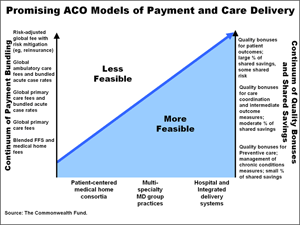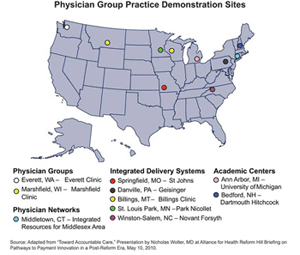The Patient Protection and Accountable Care Act of 2010 (ACA) establishes a new category of health care provider—the accountable care organizations (ACO)—within the Medicare program, with rules for provider participation and principles for sharing in the savings generated by this form of coordinated health care delivery. In this second blog post in a series on health care financing, we address the promise and pitfalls of ACOs, which are responsible for patients across a continuum of care, including preventive, primary, specialty, emergency, acute, and post-acute care.
Holding a single entity responsible for patients across the care continuum is intended to reduce the costs, errors, and frustration that arise from our fragmented health care delivery system. Even when individual services meet high standards of clinical quality, there is often poor coordination across providers, services, and settings, as well as poor communication among providers and patients and their families. The focus is on high-cost interventions rather than high-value primary care. And there is often an accountability void when it comes to the total care of patients, patient outcomes, and the efficiency with which resources are used.
The way the nation pays for care fuels this fragmentation. Fee-for-service payment emphasizes the provision of health services by individual providers rather than care coordinated across providers. The fee-for-service approach also undervalues primary and preventive care while offering strong incentives to provide complex services, even when simpler, lower-cost treatments may be better.
By coordinating care delivery as well as payment, ACOs have the potential to improve quality and achieve savings. As discussed in last month's blog post, moving away from fee-for service payment to more comprehensive payment methods, with rewards for quality and shared savings from efficiency gains, could transform patient care. Payment methods such as primary care medical home fees, bundled acute case rates, and global fees for total care of populations require new approaches to delivering care, such as teams supported by electronic information systems. The ACA includes provisions to enable ACO providers to share in savings achieved, for example, by eliminating duplicative and wasteful care and preventing costly hospitalizations and emergency care. A recent Commonwealth Fund survey showed that a strong majority of health care opinion leaders feel that providing such special ACO payment arrangements and incentives will foster greater accountability, coordination, and integration in the U.S. health care system.
The ACA specifies the broad framework for creating ACOs, but whether the promise of this new payment and delivery model is realized will depend on safeguards to avoid some of the pitfalls that have plagued past efforts, implementation decisions made by the Centers for Medicare and Medicaid Services (CMS), and the willingness and ability of the health care provider community, other payers, and the general public to respond to this opportunity.
The Managed Care Era: The Pitfalls
The rapid growth of managed care in the 1990s and its failure are instructive to the development of successful ACOs today. Although the term "managed care" was applied indiscriminately to health maintenance organizations (HMOs) of all types, such organizations ranged from integrated delivery systems with group- or staff-model physician practices, with their own hospitals and health plans, to more loosely organized networks of independently practicing physicians. While the management of care was particularly limited in the network model organizations, the more organized health care delivery systems—such as large group practices and integrated health systems—were able to institute disease and case management programs that improved care and reduced the need for hospitalization. When pioneering but rudimentary measures of clinical performance were developed in the mid-1990s, the group- and staff-model HMOs performed better, on average, than the networks.
Several lessons can be extracted from the managed care era:
- Public Backlash. Patients rebelled when they were not able to get the services their physicians recommended and they believed they needed.
- Excessive Provider Financial Risk. A number of providers in capitated (fixed per-patient fee) contracts with insurers were hurt financially as they assumed risk for services beyond those they provided directly.
- Incoherent Payment Methods Across Payers. As each major insurer developed its own payment methods, negotiations over payment rates, and systems of rewarding quality and efficiency, administrative burdens on providers escalated.
- Local Barriers. So-called "managed care organizations" in the 1990s were not successful in many parts of the country, particularly in areas that did not have large group practices, including some urban areas such as New York City and rural areas.
- Implementing Effective Practices Requires Assistance. The redesign of care to improve quality and efficiency is often a difficult and uncertain journey, requiring resources and expertise beyond most physician practices and hospitals.
- Public Preference for Smaller Physician Practices. Patients generally prefer small physician practices and their more personalized approach to care over larger groups with many part-time physicians and coverage arrangements in which they are less likely to see the same physicians over time.
- Market Power. During the late 1990s and early 2000s, the insurance industry underwent substantial consolidation, increasing its ability to set the terms of provider payment. Providers began to push back by dropping out of networks or forming their own larger negotiating entities. Insurers responded by increasing provider payment rates and raising premiums. The consolidation of market power, whether by managed care organizations or providers, runs the risk that any savings from care coordination and reduced avoidable hospitalizations or rehospitalizations will not be passed on to employers and patients.
Stakeholders must be aware of these concerns as they work toward developing and disseminating the ACO model. The following contemporary examples of accountable care, which are built on foundations of strong primary care, have managed some of these issues and offer lessons stakeholders may want to apply to their initiatives.
Lessons from Organizations that Deliver Accountable Care
A leading example of accountable care—and one used by policymakers as they wrote the health reform law—is the Medicare Physician Group Practice (PGP) demonstration launched in 2005. The five-year demonstration gave 10 large practices the opportunity to share savings resulting from improvements in the quality and efficiency of care delivered to Medicare beneficiaries. The PGP demonstration involved large multispecialty group practices chosen for their capacity to engage in system redesign and geographic diversity. The practices encompass different organizational models: two are physician groups with no formal affiliation with a hospital, five are integrated delivery systems, two are practices affiliated with an academic medical center, and one is a network organization.
All 10 practices achieved benchmark performance on almost all quality measures within the first three years, and five practices received shared savings payments by reducing the trend in Medicare outlays by a cumulative 2 percent or more. Strategies for improving performance varied across sites, ranging from efforts to better control chronic conditions such as diabetes and heart failure to the assignment of nurse case managers for patients at high risk of emergency department use, hospitalization, and rehospitalization.
Other ACO models include state government and private initiatives. Community Care of North Carolina (CCNC) is a public–private partnership between the state and 14 nonprofit community care networks that deliver elements of a medical home to low-income adults and children enrolled in Medicaid and the Children's Health Insurance Program (CHIP). Evaluations have found a 40 percent decrease in hospitalizations for asthma, 16 percent decrease in emergency room use, and total savings to the Medicaid and CHIP programs of $535 million over five years. Similarly, Group Health Cooperative in Seattle achieved savings, improved quality, and reduced physician burnout though the implementation of a patient-centered medical home model.
Blue Cross Blue Shield (BCBS) of Michigan, in cooperation with the Michigan State Medical Society, has implemented a physician group incentive program to encourage adoption of the patient-centered medical home model. The program includes over 8,000 physicians, including 5,000 primary care physicians associated with 38 physician organizations, serving 2 million plan members. Incentive payments to these organizations of approximately $100 million a year reward infrastructure development (for electronic health information systems and redesigned care processes), improvement on measures of population-level quality and cost, disease management services, and more. A Commonwealth Fund–supported evaluation of the program's results is in progress at the University of Michigan.
BCBS of Massachusetts has piloted a monthly, risk-adjusted global payment that covers all services delivered for a patient over an episode of care. Nine health care organizations now participate in these alternative quality contracts, including one-fourth of all primary care physicians in the BCBS network and 13 affiliated hospitals, serving 31 percent of the 1.2 million HMO members. An evaluation at Harvard University funded by the Commonwealth Fund is in progress.
North Dakota, in part as a result of a shortage of specialist physicians, has pioneered a team approach to care using advanced practice nurses and pharmacy technicians, and created large statewide systems of care to provide telemedicine and other support to frontline clinicians.
Model ACOs also include integrated delivery systems, such as Geisinger Health System in rural Pennsylvania, which uses a portfolio of evidence-based best practices, performance-based compensation arrangements, and an electronic health record system. A Commonwealth Fund series of 15 case studies showed how diverse types of organized health care delivery systems promote higher performance through information continuity, patient engagement, care coordination, team-oriented care delivery, continuous innovation and learning, and convenient access to care.
Experiences from each of these organizations can inform the development of the new ACOs to be created under the ACA.
The ACA: Testing Payment and Delivery System Models
The ACA contains a number of provisions that, if implemented in a thoughtful and integrated way, could provide timely evidence on new payment and incentive models for ACOs. In January 2011, the Centers for Medicare and Medicaid Services (CMS) will establish an Innovation Center to test approaches to payment reform. Starting in January 2012, CMS will begin approving ACOs for participation in a shared savings program.
We urge CMS to test at least three ACO delivery system models under the auspices of the Innovation Center: 1) patient-centered medical home networks with infrastructure provided by states, private insurers, or Medicare, with shared funding; 2) multispecialty physician group practices with Medicare, states, and private insurers as partners in providing information and support as needed; and 3) health/hospital systems with some combination of employed physicians, owned/physician practices, and group practice contracts, with insurers as part of the health systems or serving as partners in sharing risks and providing other value-added services. Rather than selecting any one of these ACOs as the definitive model at this stage, it is important to try several approaches and learn more about their effectiveness, relative advantages, and unforeseen consequences.
The Innovation Center should also consider the following five promising payment models; each has increasing levels of shared savings and shared risks through bundled payments for larger, more integrated organizations (see exhibit):
- blended fee-for service payments and medical home coordination fees, with quality bonuses and opportunities for shared savings;
- global primary care fees, quality bonuses, and opportunities for shared savings;
- global primary care fees, acute hospital and post-hospital case rates, quality bonuses, and opportunities for shared savings;
- global ambulatory care fees, including for specialist services, acute hospital and post-hospital case rates, quality bonuses, and opportunities for shared savings; and
- shared savings and shared risk, adjusted capitation with risk mitigation (e.g. stop-loss), and quality bonuses.
 These "mixed" payment models permit participants to choose among various levels of shared savings and risks, and to apply relevant performance metrics. Primary care networks, for example, might be paid a medical home coordination fee or accept a global primary care fee in lieu of additional fee-for-service compensation. Such a global primary care fee, of course, would need to be risk-adjusted for the patient population served.
These "mixed" payment models permit participants to choose among various levels of shared savings and risks, and to apply relevant performance metrics. Primary care networks, for example, might be paid a medical home coordination fee or accept a global primary care fee in lieu of additional fee-for-service compensation. Such a global primary care fee, of course, would need to be risk-adjusted for the patient population served.
Global ambulatory care fees covering both primary and ambulatory specialist care, as well as bundled fees for inpatient physician services, would be particularly suitable for multispecialty physician group practices. With the right partnership with other providers or payers, such practices also might accept a bundled case rate for hospital and post-hospital acute care. For example, Medicare could continue to pay hospitals and post-acute care facilities under its current rules and deduct those payments from the bundled acute case rate paid to the group practice. With reinsurance or stop-loss provisions, this approach would eliminate major downside risks for the practice.
Large hospital systems or integrated delivery systems with their own dedicated physician group practice or employed physicians might be willing to enter into risk-adjusted global fees (or capitation), if they have the necessary risk-mitigation support from Medicare and Medicaid claims payment for services provided outside of the system.
In each of these payment models, the ACO would share in savings based on any reduction from projected trends in Medicare per-beneficiary spending (risk-adjusted). But the extent of shared savings would vary depending upon how much risk the ACO was willing to accept. A primary care network might have quite modest shared savings (e.g., 5 percent of savings generated) while an integrated delivery system might have significant shared savings (e.g., 50 percent of savings generated).
Similarly, primary care network performance bonuses might be based on preventive care and chronic care management performance metrics, while large hospital systems might have rates of hospital-acquired infections, surgical outcomes, or survival rates as a basis for performance bonuses.
Experience with these payment and delivery models should be monitored on a real-time basis. Promising results should be fed into deliberations of the Independent Payment Advisory Board (IPAB) to form the basis for recommendations that could be extended across the Medicare program. Ideally, the IPAB would also make non-binding recommendations for other payers. Medicare should, to the extent possible, actively seek the participation of private payers and other government payers, including Medicaid.
In short, ACOs hold significant promise to help transform the U.S. health system, but much work needs to be done to establish and spread this model of care. Success will require trust among all the parties and willingness to test multiple approaches, measure results, and adapt rapidly to improve them. Government leadership and flexibility are essential, as are motivated clinicians and patients who embrace accountability for better care and health outcomes. If all this occurs, ACOs can play an instrumental role in helping achieve a high-performance U.S. health system over the coming decade.





